Written by Joel T. Lewis‘Batman: Shadow of the Bat’ #52 – ‘Nightmare on Gotham’ Part 3: ‘Safe as Milk’ 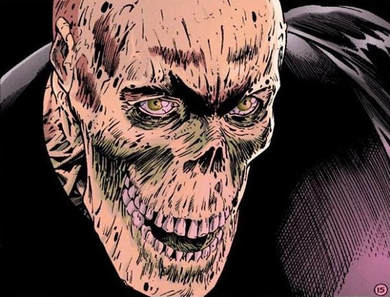 In ‘Safe as Milk’ author Alan Grant managed to take a seemingly silly premise, a maniacal villain who at first glance looks like a man in a pig mask, (fans of Professor Pyg will forgive me) whose master plan is to lace milk with a hallucinogenic toxin, and turned it into something truly horrifying, disturbing, and ultimately iconic. More than anything, what this issue imparted to me as a youngster was the fine line Batman plays between the wacky and zany, and the sinister and disturbing. To this day I can’t believe the villain introduced in this book has a total of only 5 appearances and all of those 5 occur within the ‘Shadow of the Bat’ series. The Tragedy of Narcosis echoes so poignantly in the alleys of my mind that it’s hard to believe that his tenure as a member of Batman’s rogue’s gallery was so short-lived. Beneath that strange sheet of a mask, a cowl that managed to be equal parts the draping of Cobra Commander and the skeletal outline of Black Mask, is a pretty sympathetic victim turned villain. Narcosis was a toddler taken in by social services after the arrest of his father and the hospitalization of his mother. Left alone in the kitchen he overturned a boiling pot of soup onto himself which in turn burned his face clean off. Ten years of failed skin grafts and a lifetime of waking nightmares later and you get Narcosis. Now look, a fear driven hallucinogen plot and a villain with a burned face aren’t exactly original concepts, especially within the Batman mythos (which probably why Narcosis faded into the background never to reappear) but the tragedy of this villain’s disfigurement hits harder than Two-Face’s ever did and the motivation for his nightmare gas plan is so much more personal than any of Scarecrow’s. Harvey Dent was an adult who was disfigured by Salvatore Maroni as a response to the overzealous efforts of Dent as district attorney. He was a man who knew the risks involved in taking on the Gotham underworld, and his accident, while tragic and traumatic, was a retaliation. Narcosis is the product of a childhood accident, a villain whose innocence was stripped from him by chance, born out of negligence rather than malice. As a kid myself reading this issue for the first time, those images of a tiny arm outstretched in hunger and a child’s mouth swallowed up by the roiling splash of scalding hot soup were imprinted in my mind. I felt like that could have been me. Reading it again after all these years I still feel like that could have been me. The cruelty of chance evident in this issue is staggering and the juxtaposition of the monstrous scarred adult that Narcosis became with the innocence of that hungry child reaching for his dinner hits me just as hard today as it did upon first reading. There is an interesting parallel in the way Batman dispatches Narcosis in this issue and the tragic birth of the Joker in ‘Killing Joke’. While the Joker leapt away from a pursuing Batman and was baptized in the chemical soup of an Ace Chemical vat, Batman kicks Narcosis through the thin metal railing of the catwalk above a toxin-laced vat of milk. You get the sense that Batman has no pity for the poor creature he’s doomed to intensified horrors for the rest of his life and the similarity between the Joker’s birth and what Batman does to Narcosis must have occurred to him. The horror on Narcosis’ face, the desperation of his scream of ‘Nnno!’ on the way down, and his gasping attempts to tread to the surface of the milk fueled nightmare of his own making are truly disturbing images that I’ve never forgotten. 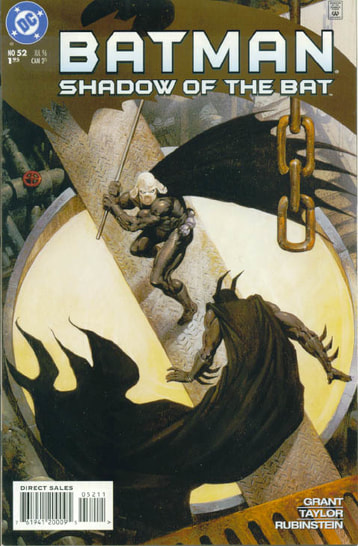 This issue is also unique in that Batman and Robin rush off to the dairy as the first light of morning is breaking. The strangeness of Batman coming out during the day really never occurred to me, even to this day, though I do think of Batman as an agent of the night, I’ve never balked at the notion of the cape and cowl appearing during the day. This issue cemented in my mind from an early age that Batman is not confined by time, space, or context. Harvey Bullock will have to excuse me because for me, the Bat does fly by day. Dave Taylor’s art in this issue haunts me to this day. The detail, texture, and pain he conveyed in Narcosis’ face and the shape and contour of the villain under his veil is without peer as far as I’m concerned. There’s a sick beauty to the terror Taylor accomplished in this issue and his take on Bruce, Tim, and even Commissioner Gordon speak to his skill at capturing the essence of these iconic characters. The noir portrait on page 7 of Gordon, trench coat sent flapping in the wake of a grieving aunt’s limousine set against the pale morning silhouette of Gotham City in the distance is so powerful in its simplicity. As I come to end of my secret comic book origin story, I must say it’s interesting to trace the lens through which I consume comics back to the issues that inspired me as a kid. These books served as the pillars of my comic book fandom and admittedly they’re pretty strange, but that’s half the fun! I hope you’ve enjoyed this series of articles! Until Next Time, Geek On!
0 Comments
Written by Joel T. Lewis'Batman' #531 - 'The Deadman Connection' Part 2: 'Cult of the Mummy' 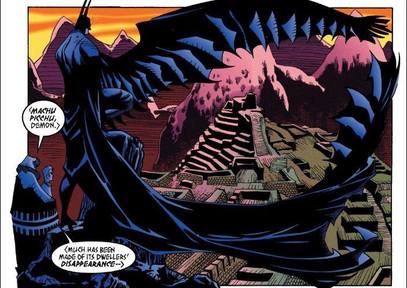 This is the issue that is perhaps the most difficult for me to analyze because it was the one that did the least to hold my hand in a narrative sense. I didn’t know who Boston Brand was, what Deadman’s powers or origin were, why Batman was travelling to Machu Picchu, or what the strange skeletal specter dressed in red (Deadman) was doing possessing a body that proceeded to get more and more bullet ridden, and fly infested. I know now that a group of mercenaries discovered a hidden Incan city near Machu Picchu and took control of the city’s treasure by claiming to be Incan deities. Doubting the postured holiness of these new invaders, the Shaman of the Incan descendants then sent the spirit of one of their ancestors to Gotham for help where the limbo-cursed former acrobat Boston Brand (Deadman) and Batman were puzzling over Gotham’s sudden influx of strange ancient artifacts. Brand mistakenly gets his current corpse host murdered trying to save the wrong people, and teams up with the Dark Knight to investigate the origin of the artifacts and the Incan spirit who compelled one of the traffickers to take his own life. Though this arc is only three issues long, much of the necessary exposition for the narrative comes from the first issue, an issue I’d never seen before this week. So needless to say, I was lost in this issue from the jump, but then author Doug Moench didn’t help matters any on page 3 when he flexed Bruce Wayne’s rather large frontal lobe. Mr. Moench, cruel man that he is, wrote a meticulously nuanced analysis of the quantum mechanical basis for both the ‘Holographic Theory of the Universe,’ and the ‘Principle of Non-Locality.’ To be honest dear reader, I’m not sure if I ever read all the way through this lengthy jargon riddled exchange between the Dark Knight and his butler. But in retrospect, this sequence establishes both Bruce Wayne’s sizable knowledge on even the most obscure of scientific theories and the well-reasoned analysis on which he’s based his belief in, (or perhaps his willingness to entertain the notion of), the supernatural elements at play in this arc. Batman is a logical being, whose detective mind and critical methodology are securely fastened to a world explained by science, so his reasoning out of the possible scientific justification for the existence of what you and I and Boston Brand would call Ghosts points to the flexibility of intellect and imagination of the caped crusader in dealing with the supernatural. Despite my confusion, the visual strength of this issue, and the skilled storytelling that Kelley Jones’ artwork accomplishes in conjunction with (and sometimes despite) Moench’s effusive prose, taught me the value of art’s role in a comic book. The height of Batman’s ears in this book and the wide feathery texture that Jones gives his cape are images that will endure in my mind forever. Batman is dripping with cape, engulfed in it, swallowed up in it, but it also seems like an extension of his body. The bizarre surreal musculature of Deadman and Batman and the bluish decaying detail of the corpse Brand has been possessing are executed to perfection. 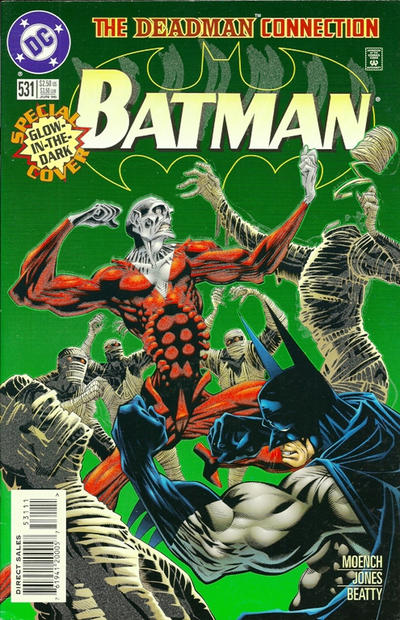 This issue also sports a pretty unique page layout as Batman engages in a philosophical debate over the nature of symbols, demons, and evil with Chimu, the Incan Shaman who he asks to lead them to Machu Picchu. As the lines of their conversation in translated Spanish play out over the vast white space in the middle of the page, the only figures on the page are the stoic portraits of the Bat and the Shaman that bookend the conversation. The use of the prose splash page here is pretty unique and very effective in its contrast in color and tempo compared to the rest of the book. In the measly 8 panels in which he appears in his spectral form in this issue Deadman left quite the impression. The alien dome of his skull and the unnatural curling of his spine in that vibrant red costume is so surreal and grotesque an image that you can’t help but look, and look for him again as you turn the page. The irony of so flamboyant and scary a character being invisible to the living observer is not lost on me. The small panels that show the Deadman in action are devilish in their simplicity as he extends a pale thin hand into a machine gun toting grunt’s mind, making him knock himself out. Also that final image of Brand re-entering his borrowed corpse, toothy skull first is one that has haunted and delighted me for years. Wordy, heady, philosophical, and visually spectacular, issue 531 expressed to me the power and flexibility of comic books to accommodate lengthy discourse on quantum mechanics and the nature of evil, while also leaning on the motion and skill of its artwork to move the story along. Though I never quite knew what all was going on in this issue as a kid, the power of Kelley Jones’ artwork kept me coming back to this issue time and again. In the fourth and final chapter of my comic book origin story, I’ll take a look at my introduction to one of the most sympathetic and terrifying Batman villains I’ve ever met in Batman: Shadow of the Bat #52. Until Next Time, Geek On! Written by Zeke Perez Jr.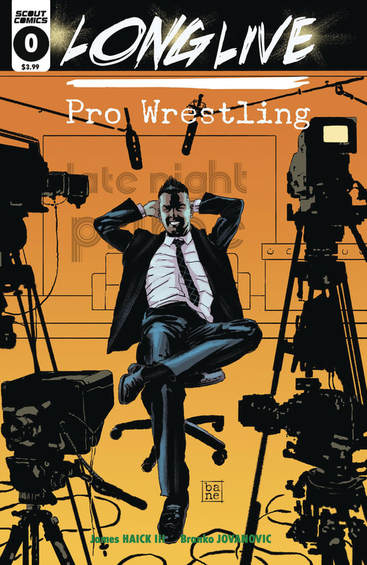 Every so often I search for something new when I head into Mile High Comics on New Comic Book Day. I seek out a change of pace from the usual superheroes and publishers that are on my pull list. Luckily, my scan of the new comics rack came just in time to get in on the front end of an exciting new story. Drawn in by the title and cover, I snagged the last remaining copy of Scout Comics’ Long Live Pro Wrestling #0 this past week. Issue #0 sets the tone for what looks to be a fun and interesting look at the world of professional wrestling. From the first issue alone, I get a feeling that this series will take me on a personal journey of who I am as a wrestling fan, from how I felt about it when I was a kid who was captivated by the characters and the storytelling, and moving to how I view it as an adult with an appreciation for the athleticism and the behind-the-scenes lore. I first became a fan of wrestling when I was around 8 or 9, joining in with my obsessed neighbors as Stone Cold Steve Austin and The Rock dominated the WWF. I too fell in love with it. I started watching weekly, getting my parents to take me to live events when they came through Denver and trying to share it with any and all of my friends. I maintained a die-hard level of interest through most of middle school but went on a hiatus entering high school. It’s easy to lose interest at that age as your ability to suspend disbelief wanes amidst a barrage of people pointing out how “fake” it is. A few of my high school friends enjoyed it though, so I would casually keep tabs on it through them. My hiatus extended through college and deepened as I was unable to find anyone who was interested in it. I lost track of who the current wrestlers were and stopped paying attention. At some point post-college, I was itching to get to a live event, purely for nostalgic reasons. Then, a few years after that, my good friend (and NTG colleague) Joel gave WWE a watch for the first time and got hooked. Having someone again to share in it with, I’ve started to get back into it. I’ve found that being a fan of pro wrestling these days is much different than when I was a kid, not only due to my change in perception of the sport but also because of how the wrestling universe at-large operates. Fans take to social media during and after each show to discuss and critique the writing, the wrestlers, and the overall product. The conversation, good and bad, seems never ending on Twitter. Shows like GLOW and YouTube programs like Botchamania and What Culture Wrestling reframe how fans watch, interact with, and think about wrestling. They unlock the door to the entertainment and provide a deeper insight into everything behind the magic. So, getting back to Long Live Pro Wrestling (and forgive my preceding tangent), the comic series appears to play off of all of those aforementioned issues. It examines how the public and wrestling fans each perceive pro wrestling, grappling with the disconnect between the two groups. It should resonate with fans who have seen themselves grow in how they watch it. At the very least, the first issue puts forth a plot that will certainly ring true with wrestling fans. Issue #0 focuses on Evan Dandy, a famous former wrestler who crossed over into mainstream pop-culture and entertainment popularity. Dandy is coming out with a network show that will share the terminology and backstage secrets of pro wrestling. He hopes the show might win over the general public and get them to fall in love with pro wrestling by framing it as an art form. But things don’t go well when he sits down with a smarmy TV host named Lance to promote the show. The conversation sours when Lance prods Dandy with personal barbs and attacks on wrestling. The two have an exchange about wrestling that all fans surely have had at some point. About how ‘predetermined’ does not mean ‘fake’ and how a suspension of disbelief is necessary. About how a great match can tell a story, and how enjoying a good storyline is no different than enjoying the fiction in a movie or TV show. The interview turns hostile and the issue ends with a nice twist and a solid setup for the rest of the run. Through his writing, Long Live Pro Wrestling’s creator and author James Haick III begins to capture the passion that exists for pro wrestling. I also enjoyed Haick’s ability to quickly build tension and intrigue in the story. He mixes in some very real issues facing the industry, discussing the threat of MMA as a competitor and the drug addictions like those that some real-life wrestlers have faced. All of this is complemented extremely well by artist Branko Jovanovic’s realistic drawing style and colorist JM Ringuet’s bold tones and shadows. The total package of the bold lines and stark colors is an enticing beginning to a story that looks as good as it reads. There are a number of wrestling comics out on the market right now, including WWE’s own titles. Long Live Pro Wrestling starts off with an issue that is very much an introduction and a table setter, but it heads in an interesting direction with a lot of potential. Scout Comics’ Long Live Pro Wrestling #1 should hit shelves in early September. Be sure to pick up a copy to see where the story heads next! Written by Joel T. Lewis'Batman' #514 - 'Prodigal' Part 9: 'One Night in the War Zone'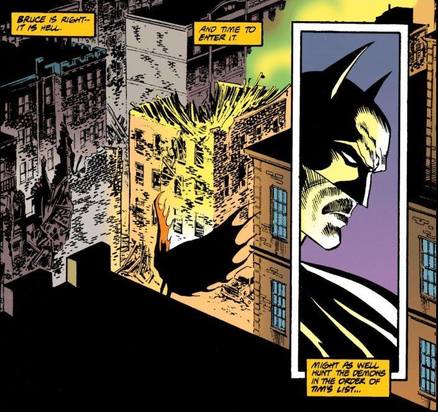 ‘Prodigal’ Part 9 was a one-shot story in the middle of a rather lengthy arc wherein Dick Grayson fills in for Bruce Wayne as the Dark Knight for the very first time. I’ve found from my recent Comixology-fueled research that the preceding 8 issues of the arc focused on the insecurity of Dick stepping into the role and going up against perhaps his first and worst foe Two-Face. But in this issue, we see Dick face off against 3 gimmick-less killers in the Battergate Burrow, affectionately known to Gotham’s finest as ‘The Warzone.’ With no costumed baddies, no larger conspiracy plot, and no Robin, this issue is all about Dick testing himself against the underworld proper of Gotham City. We see him pushing himself to see if he is indeed worthy of wearing the symbol of the bat over his chest, to see if he’s capable of the dedication and stamina necessary to sustain the Batman’s crusade. This reinforced in me early on that other people could step into the role of Batman, and introduced me to one of my favorite things in Batman comics: Dick Grayson as Batman. Dick is my favorite Robin, he’s my favorite member of the Bat-Family, and he’s also my favorite Batman. Even though this issue was my introduction to the acrobat donning the cape and cowl, I didn’t enjoy reading it the way I would Batman: The Black Mirror years later for a number of reasons. I’ve never really been a fan of the artwork, (which is in no way a dig, just a subjective opinion), I didn’t find the villains particularly interesting (three street level murderers weren’t as flashy to me), and knowing that there were 8+ issues left of the story that I hadn’t read didn’t help either. But what it imparted to me was how competent Grayson’s Batman was, how much Bruce asking him to take over meant to him, and the lengths to which he was willing to go to fill the role entrusted to him by his mentor. You really feel the weight of the Batman crusade in this issue. After the 8 issue slog of handling the larger Two-Face plot that I’ve only recently read in full, Dick feels, as most of us would, that the closure of that caper should mean a break for the caped crusader. Even after dispatching the 3 escaped murderers in this issue Batman hears 3 new gunshots and a distant scream puncture the false tranquility of the night. There is no closure for Batman. The mission is never-ending, and Grayson even says in this issue that there’s only one man who’s cut out for the endless sequence of screams, vengeance, and justice that Gotham breeds and needs, and he’d better come back soon. 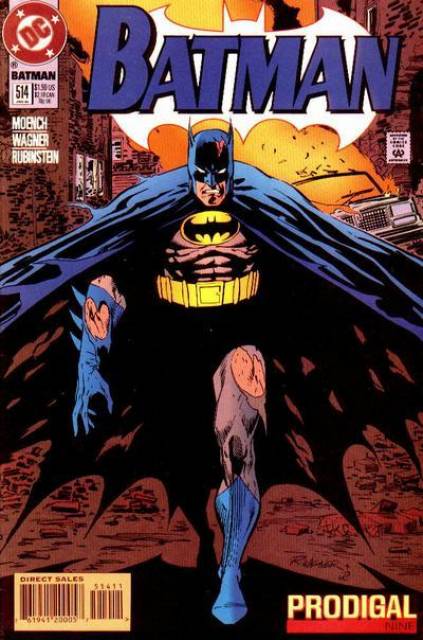 This issue offers a really interesting voice for Dick Grayson as his internal monologue turns towards self-examination. I didn’t understand the value of these words from page 18 upon my first reading of this issue, but the weight they carry hits all the harder now, ‘Blew it with the Titans...Lost my way as Nightwing. I’m too old to be Robin...and being the Batman on a grim tour like this certainly isn’t me. But what is? What am I? Other than a reluctant grunt in a foreign war zone.’ The connection between this self-analysis of identity, this confusion of roles in Grayson here and Jean Paul Valley in the first issue I looked at in this series, is a pretty staggering coincidence. Both are members of the Bat-Family who’ve taken the mantle of the bat and feel a strong connection between their success or failure under that cowl with how they perceive their own identities. The through-line of the Batman’s impact on identity and self-reflection between these two issues cemented that commentary in my mind as central to the Batman mythos. The impact of this traumatic construct, how poorly it fits people who didn’t create it, and the ways those outsiders try to adapt it as a result of that poor fit is very much where my fascination with the character lies. Though the artwork of this issue didn’t really blow my hair back as a child, looking back at it now there are some iconic panels from artist Ron Wagner that are worthy of praise. Seeing Hsui Cheung in motion as he brains his former associates with TV sets and tosses deadly shurikens is really impressive and compelling and there is a particular panel where Dick pauses a moment before descending into crumbling Battergate Burrow which is striking in its texture and squalor. Also, there is a particularly funny sequence wherein the drug lord Bonaventure Strake finds his fist stuck in the bell of a pawn shop sousaphone that’s always tickled me and the panels from page 18 that I quoted above have very clear simple lines, leaning on the strength of the caped crusader’s silhouette to mirror the deep contemplative tone of Grayson’s internal monologue. This issue hammered home the idea that there is no end to the Dark Knight’s mission, that though I would close the cover of the comic and go away from Gotham for a while, while the book remained closed a man dressed as a Bat would continue to battle a city whose primary exports, gunshots and screams, would never be in short supply. Also, I would be remiss if I didn’t acknowledge that this would have been my first exposure to author Doug Moench, who I would later fall in love with as the creator of Moon Knight (which might be the reason old Moonie felt so familiar to me). In the next chapter of my comic book origin story I’ll discuss an issue that always threatened to go over my head. Part 2 of 3 of an arc guest starring Boston Brand’s Deadman and sporting a lengthy analysis of the ‘Principle of Non-Locality’, Batman #531 is a really unique counterpoint to the issues I’ve already covered. Until Next Time, Geek On! Written by John Edward Betancourt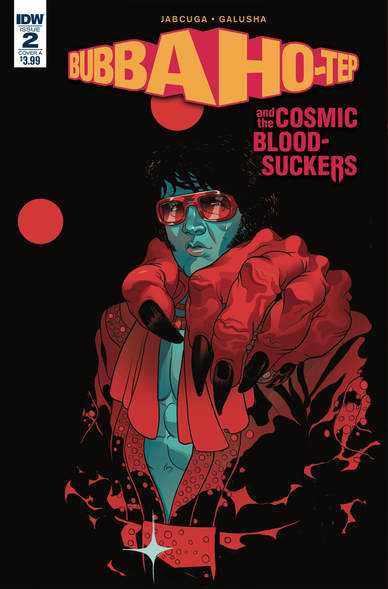 There was a time, where I simply could not wait to read a brand-new comic book. The possibility of missing out on something pertinent in either the DC or Marvel universe seemed like a nerdy crime and when I was younger, you’d find me at the Comic Book store on New Comic Book Day the first chance I had to get down there, because I had to know what was coming next in a particular story as soon as possible. But alas, as the years progressed, that excitement has unfortunately waned, and while I do my best to keep up with what’s happening in the comic world, I don’t quite rush out to grab the latest issues like I used to. But oddly enough, my attitude on that is starting to change. Because Bubba Ho-Tep and the Cosmic Blood Suckers is a comic series that is starting to revitalize my love of comics and for the first time in a long time, I’ve been anxiously awaiting the brand-new release of the next chapter in this wild story that features a Bruce Campbell inspired Elvis Presley fighting monsters in the shadows and wouldn’t you know it? Issue #2 of this magnificent series arrived in stores this week and thanks to our very own Joel (whom I cannot thank enough for picking this up for me), I was able to get my hands on a physical copy of this comic and my goodness, what an incredible treat this turned out to be. Because it’s inherently clear that Writer Joshua Jabcuga wants to take us on a vastly different kind of horror themed journey, one that defies convention and that was inherently clear from the surprising tone and design of this issue. For this could have been an action-packed battle royale, with the King and his gang tearing through an army of monsters before enjoying a round of fried peanut butter and banana sammiches, but instead, we were treated to a powerful slow burning story. One that established the rules for the rest of the series and provided us with some fascinating backstory for the monsters in question and I appreciated the fact that this issue focused on all those important elements now rather than shoehorning them in later. However, while the story is supremely important, we cannot talk about this issue without talking about the incredible art. Because Artist Tadd Galusha and Colorist Ryan Hill have outdone themselves in this one. The visuals here are quite literally a feast for the eyes since Galusha and Hill’s work not only leaps off the page with incredible colors, especially when we go on one wild, drug fueled trip through multiple dimensions, but it maintains a beautiful 1970’s horror aesthetic, making this comic feel like a true prequel to Bubba Ho-Tep and a genuine horror classic and the art is so incredible in this issue that I outright had to go through every single page twice. Once to read the story, and once to admire all of the art and give it the proper tribute it deserved. Yet, while I enjoyed and savored every single page that I poured over in this issue, there was a sense of sadness that came with finishing this particular tale because, I’m absolutely and utterly hooked at this point, and I’m starving for more. I’m dying to know how the King’s supernatural tryst is going to save everyone from the forthcoming armada of evil that’s on its way to their doorstep and more importantly, I cannot wait to discover how the King and his friends are going to send the monsters that have come to our world back to where they belong. But alas, I will have to wait to see all of those things play out and I’m fine with that, because this series is worth the wait, but this time around, when a new issue hits the stands, you’ll find me back in line on New Comic Book Day, because this magnificent series, has me anxious and ready to hold a brand new issue in my hands to see what wild adventures await Elvis Presley in his fight against those gol’ darn cosmic blood suckers. Until next time. Written by Joel T. Lewis'Batman: Legends of the Dark Knight' #63 - 'KnightsEnd Part 10: Climax'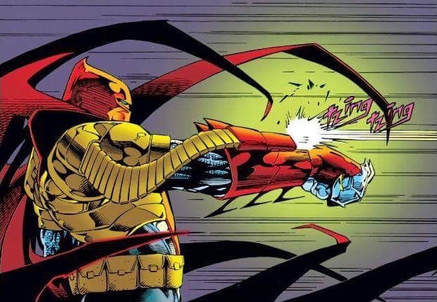 Of all the comics books I’ve ever owned, this is the one I’ve read the most frequently. It’s my favorite comic book. Of all time. And it’s not a Moon Knight comic. This is the epic conclusion of one of the most contentious comic book events of all time, the aftermath of Bane breaking Batman’s back (try saying that five times fast), the passing of the mantle to Jean Paul Valley, the disturbed young man conditioned from before birth to become Azrael the Avenging Angel, and Bruce Wayne’s recovery and return to reclaim his dark twisted crusade from the overzealous violent claws of his unworthy successor. I know all this now, but thumbing through the pages of this comic for the first, second, even the 50th time I had no idea the depth of the story that came before, the controversy that surrounded it, or the significance of Bruce reclaiming the mantle in this issue. Now I don’t know which came into my life first, this issue or the action figure inspired by it, but perhaps my affection for this comic, the Azbat suit, and the man inside it came from owning both the comic and my Ultra Armor Batman figure, which remains to this day one of my most prized possessions. I don’t know if I made this connection at the time, but certainly looking back on it now, to see the wackiness and diversity of Batman’s action figures mirrored in the pages of a comic book, to see that my toys had come from actual stories, made a big impact on me. Forget Woody and Buzz in Toy Story, Ultra Armor Batman had some demons. Now let’s get into the issue. It doesn’t waste any time readers. On pages 1 and 2 we see a gleaming, red, gold, and silver thing, claiming to be Batman, but more than that, claiming that Wayne Manor is his house, that being Batman is a privilege, and that Bruce Wayne doesn’t deserve to be Batman. These are the first two pages! This issue serves as the very bedrock of my fascination with Batman and his world and it directly challenges so much of the quid pro quo of that world in its first breath. From the jump there’s this idea of the mantle of the bat, of uncertainty over who it belongs to, and the twisted logic of Jean Paul who sees the mantle as a privilege, a calling to be coveted, rather than the traumatic burden that it is to Bruce. Valley then pontificates over the big highlights of the ‘KnightFall’ event referring back to Bane breaking Batman, Bruce passing on the mantle, and then running from the Bat’s Crusade. Valley then breaks the portrait of Thomas Wayne over his knee, (in a panel that I didn’t know at the time mirrored Bane’s treatment of Bruce so many issues earlier) and tears through the deceased patriarch’s face, in a dramatic visual representation of Batman being born out of the destruction of Thomas and Martha Wayne, but also of the terrible nature of Batman, of his potential for violence, cruelty, and malice as a construct separate from Bruce. The idea that Batman could exist as a separate entity, and the terrible potential for that creation without Bruce to balance it just leaps off the page. Batman proceeds to pursue Valley into the Batcave, but not through the constructed, booby-trapped avenue he himself set in place, but through the very hole he fell through as a child, where his own fear of bats, and his consequent taking the bat as his symbol began. The conflict, the madness of Jean Paul Valley, and the desperation with which he clings to his borrowed identity as Batman was not lost on me as a child, though his references to St. Dumas, and the ghost of his father went right over my head. Valley lashes out, tearing through the emblem on Bruce’s chest, a mirror of the damage he’s done to the legacy of the Batman, but even as he lashes out he screams into the chilled, quiet air of the Batcave, ‘I am Batman...because if I am not...I am Nothing!’ Bruce leads Valley through the winding labyrinth of the cave, knowing that the ever-narrowing cavern will force him to cast off the bulky, technological trappings of his techno-future batsuit, and allow Bruce to take him down man to man. And as Valley descends into the dark womb that birthed the Batman he faces Bruce stripped of all of the Batsuit save the cowl. Bruce blinds Valley by removing the baffle set in place by his father to cover the hole he fell through so many years ago bathing himself and his unworthy successor in the light of the new dawn. Valley removes the cowl and sees the truth that he is not truly Batman and Bruce lifts them both out of the cave into the light and as the issue ends, the mantle is no longer in contention, and the Bat stands in the sun. 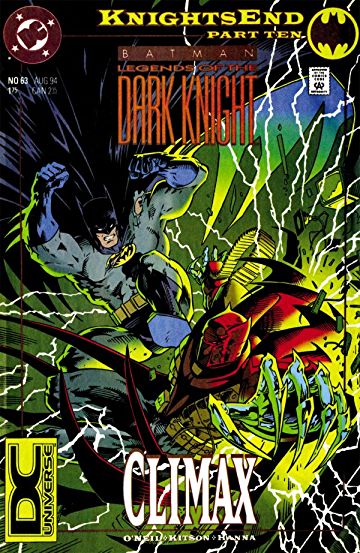 In many ways, this was my introduction to the origin of Batman. Bruce’s descent into the Batcave to reclaim the mantle from Jean Paul, and the claustrophobia and failure of Valley trying to descend into that dark birthing place, almost tell the origin of Batman better than the issues in which he first appeared. In this we see the growth of Batman, the deeper understanding of the man and his mantle, and the realization in Bruce that passing his crusade over to another, especially one so ill-prepared, was cruel. This shaped my understanding of the mantle of Batman and it tempered what might have been outrage at someone else taking on the cape and cowl because I’d seen it done before, and loved the twisted complexity of that dynamic. More than that, it fostered in me a fascination for the dynamics of the Bat-Family, for the twisted wheel of trauma that Batman’s crusade created and how it affected those pulled into its influence. I had the sense that other people could step into this world, even into the role of Batman, and that it would drastically reshape them, for good or ill. Let’s talk about Jean Paul Valley. It’s not an exaggeration to call him on of the most controversial comic book characters of all time. Despite all his faults, the negative reception of his suit, his line-jumping in taking over Batman’s mantle, the vague and confusing nature of his origin and the ‘system’ designed by the Order of St. Dumas that plays so large a role in his story, I have always loved this character. As a kid it was mostly aesthetic. The Azrael Batman (or AzBat) costume is just cool. In many ways the 90’s were about excess (I mean look at the number of subtitles for this issue) and this suit is no exception. The earlier appearances of the suit sported a blue, gold, and black color pallet, but in my opinion the red and gold suit has no equal. Claws? Check. Arm Rockets? Check. Curled chain magazines full of Batarangs? Check. It’s got spikes, it looks good in motion, and it steals the show in every panel it’s in. This red suit only appears in one other issue, Detective Comics #677 and in my opinion it doesn’t measure up. The detail, the shine, and the color of that suit brought to life by the combination of artist Barry Kitson and colors by the talented team at Digital Chameleon is something I’ve not seen since. Separate from the look, Jean Paul Valley represents a difficult and bold move in the history of Batman. This was the first successor to Batman, uncharted territory, and in many ways something that could not be well received by its very nature. How do you give the mantle to Nightwing, a character that had spent so much time establishing his legitimacy in his own title, in a new city, with his own rogue’s gallery? I feel like if they had gone in that direction, (which they eventually did in the ‘Prodigal’ arc which I will discuss in part 2 of this series) with the stakes as high as they were with Bane and the rest of the rogue’s gallery in play it could have undermined all the work that went into establishing Nightwing as his own man, as an independent and legitimate superhero. In many ways, that storyline required an expendable, transitionary character, someone who could be written in for a while, and written out just as quickly, and while Jean Paul fit that criteria, he managed to (despite his role as the hyper-violent 90’s techno Batman) be relatable and sympathetic in the end. His uncertainty in his identity, the manipulation of his mind, and the journey he is set upon following his tenure as Batman have cemented him as one of the great tragedies of the Bat-family, but also one of the triumphs in my opinion. The artwork in this book is breathtaking. There is an immediacy to this issue, a sharpness that has stuck with me, and informs my expectations for what comic book art can be and what it can do to this day. The detail, the execution of facial expression, and the weight of those action panels live so vividly in my memory that they serve as my template, my measuring stick for a Batman comic. The sequence of Valley descending into the narrow tunnel where Bruce fell so many years ago is so simple and effective: the jagged and bulky silhouette of the AzBat suit crouching and then crawling down this decrescendo of a tunnel conveys the weight of that suit, the closeness of the air in that tunnel, and the panic of feeling trapped in the darkness under the earth all at once. This is the issue that defined how Batman looked in my mind; how he moved, the way his face contorted as he landed a punch or took one himself, the metal of the man behind that mask, but also the compassion there as well. I was never content not knowing the story that led up to this final showdown. Before I ever scoured a long box in search of Moon Knight appearances, I tracked down the 3 volumes of the ‘KnightFall’ event. I scraped together allowances and birthday money to buy each one separately, devoured them and had to wait in narrative agony until I had enough to buy the next one. This was the first story I tracked down, and my first (and ultimately the most satisfying), sense of closure with a comic storyline. In the next chapter of my comic book origin story I’ll take a look at another issue where the man under the cowl isn’t Bruce Wayne, Batman #514. Until Next Time, Geek On! |
Archives
May 2024
|
|
© 2012-2025, Nerds That Geek LLC.
All Rights Reserved. |
uWeb Hosting by FatCow
